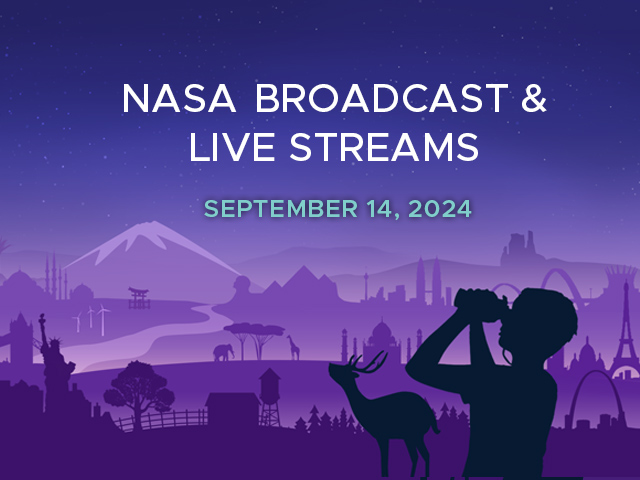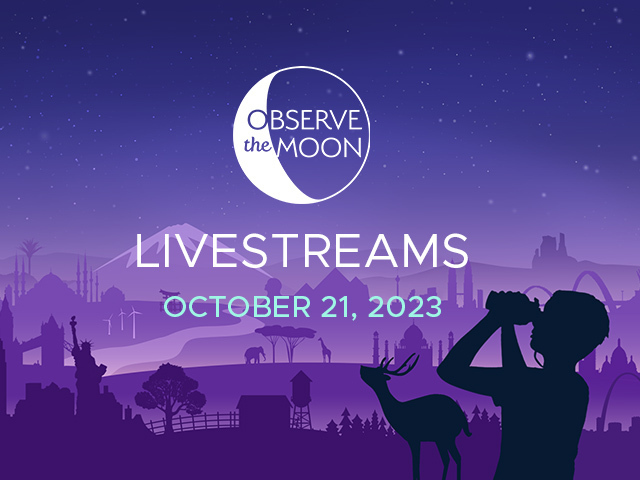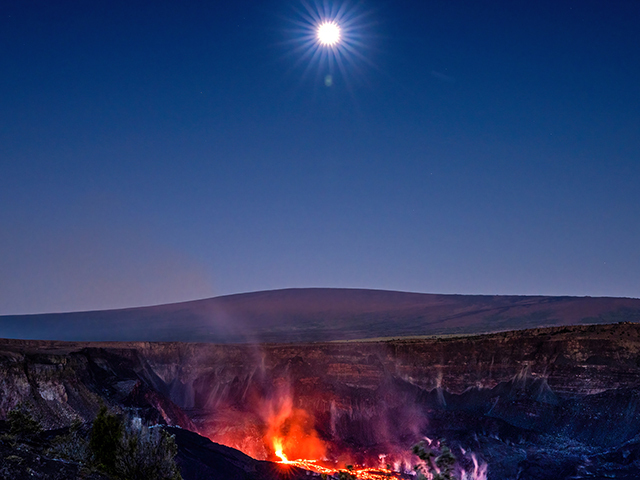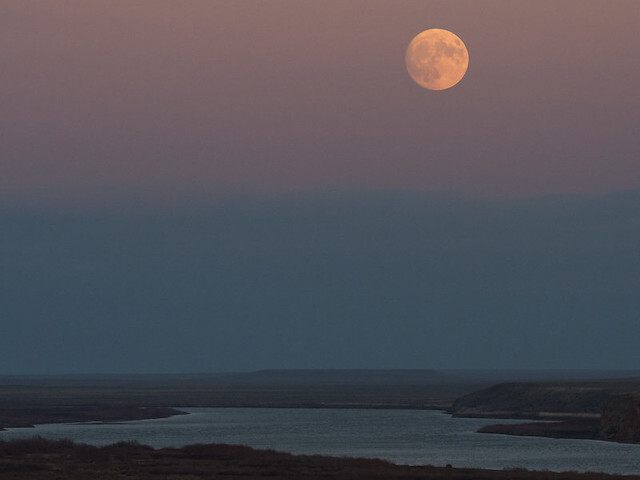News | October 3, 2017
The Next Full Moon is the Harvest Moon
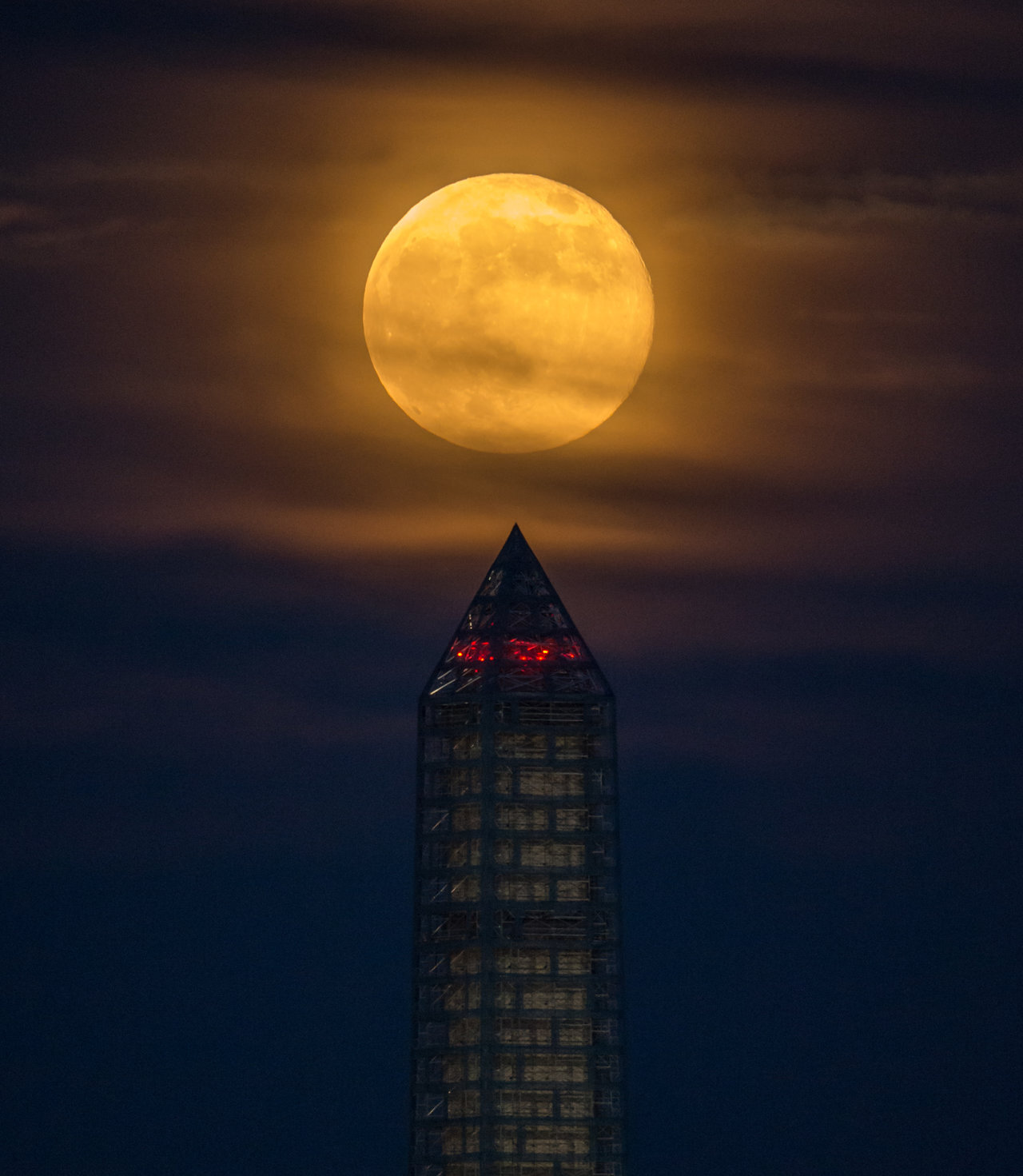
A full Moon rises behind the Washington Monument, Sunday, June 23, 2013, in Washington.
The next full Moon will be Thursday afternoon, October 5, 2017, appearing "opposite" the Sun (in Earth-based longitude) at 2:40 PM EDT. The Moon will appear full for about three days centered on this time, from early Wednesday morning through after midnight Friday night into Saturday morning.
As the full Moon closest to the Autumnal Equinox, this is the Harvest Moon. Farmers can work late into the night by the light of this Moon. Usually the full Moon rises an average of 50 minutes later each night, but for the few nights around the Harvest Moon, the Moon seems to rise at nearly the same time each night: just 25 to 30 minutes later across the northern U.S., and only 10 to 20 minutes later for much of Canada and Europe. For Washington, DC on Thursday night, October 5, 2017, the Moon will rise about 20 minutes after sunset; the next night moonrise will be about 36 minutes later. In two years out of three, the Harvest Moon comes in September, but this is one of the years when it occurs in October. The Harvest Moon is an old European name for this full Moon; Oxford English Dictionary cites the year 1706 for the first published use of the name "Harvest Moon."
On Monday evening, October 23, 2017, the planet Saturn will appear to the left of the waxing crescent Moon low near the horizon in the southwest.
The Maine Farmer's Almanac first published Indian names for the full Moons in the 1930's. According to this almanac, the Algonquin tribes of what is now the northern and eastern United States named the first full Moon of fall the Travel Moon, Dying Grass Moon, and the Sanguine or Blood Moon. The Dying Grass, Sanguine, and Blood Moon are all thought to be related to the turning of the leaves and dying back of plants with the start of fall. I have read that the name "Travel Moon" comes from observing the migration of birds and other animals preparing for the winter. I don't know, but my guess is this name may also refer to the season when the more northern tribes would move down from the mountains for the winter. For example, both the Iroquois and Algonquin would hunt in the Adirondacks in the summertime but would leave for winter.
This full Moon is also Sharad Purnima or Kojaagari Purnima, a harvest festival celebrated on the full Moon day of the Hindu lunar month of Ashvin. In India, the rainy season is over and the brightness of the full Moon brings special joy. This is a traditional celebration of the Moon and is also called the Kaumudi celebration, Kaumudi meaning moonlight. For more information on the Hindu traditions associated with this full Moon see http://en.wikipedia.org/wiki/Sharad_Purnima
In lunisolar calendars the months change with the new Moon and full Moons fall in the middle of the lunar month. This full Moon is the middle of the eighth month of the Chinese calendar and Tishri in the Hebrew calendar, which includes the seven or eight day holiday Sukkot that starts this year at sundown the night of October 4. In the Islamic calendar the months start with the first sighting of the waxing crescent Moon a few days after the New Moon. This full Moon is near the middle of Muharram, one of the four sacred months of the year when warfare is forbidden.
As usual, the wearing of suitably celebratory celestial attire is encouraged in honor of the full Moon.
As for other celestial events between now and the full Moon after next:
As fall begins, the daily periods of sunlight continue to shorten, still changing at nearly their fastest. For the Washington, DC area, on the day of the October full Moon, morning twilight will begin at 6:11 AM, sunrise will be at 7:08 AM, the Sun will reach a maximum altitude of 46.1 degrees at 12:56 PM, sunset will be at 6:44 PM, and evening twilight will end at 7:42 PM EDT. The mornings from Wednesday, October 25, to Saturday, November 4, 2017 (the day of the November full Moon), will be the darkest mornings of the year, with the latest sunrise times. November 4th will be the latest sunrise of the year, a full 12 minutes later (in Daylight Savings Time) than the latest winter sunrises in late December and early January (in Standard Time). On the day of the November full Moon, morning twilight will begin at 6:39 AM, sunrise will be at 7:39 AM, the Sun will reach a maximum altitude of 35.5 degrees at 12:51 PM, sunset will be at 6:04 PM, and evening twilight will end at 7:03 PM EDT. If you notice you have a lot of trouble waking up in the morning in late October and early November, this might be why (and even if it is not, it seems like a plausible excuse for sleeping in...).
On the evening of the October full Moon, as as twilight ends, the planet Saturn will appear about 22 degrees above the horizon in the south-southwest. The Earth and Saturn are moving farther apart, but this remains a good time to get out a telescope and admire Saturn's rings. The trio of bright stars called the "Summer Triangle" will appear directly overhead. The "Summer Triangle" is not a constellation but consists of the three brightest stars from three different constellations. To the northwest will be Vega, the brightest star in the constellation Lyra the Harp; to the northeast will be Deneb, the brightest star in the constellation Cygnus the Swan; and to the south will be Altair, the brightest star in the constellation Aquila the Eagle. If you are lucky enough to live in an area where it is dark enough to see the Milky Way, our home galaxy will appear stretched directly overhead from south-southwest to north-northeast. As the month progresses, the planet Saturn will appear to shift west towards about 14 degrees above the southwest horizon and the "Summer Triangle" will also appear to shift towards the west, such the Deneb will be the star appearing nearly directly overhead.
On the morning of the October full Moon, as morning twilight begins, the planets Venus and Mars will appear together about 11 degrees above the eastern horizon. The bright star to the upper right will be Regulus. The bright stars of the local arm of our galaxy (including the constellation Orion) will appear spread across the sky from the south-southeast to the north-northwest (although 80% of Americans now live in areas with too much light pollution to see the Milky Way). As the month progresses, bright Venus will appear to hover, then begin shifting back towards the eastern horizon, while Mars and Regulus will appear to shift higher in the morning sky. The bright stars of our galaxy's local arm will appear to shift towards the west.
The annual Orionid meteor shower will be active from early October to mid-November, peaking early in the morning of October 21 (although this shower sometimes has several peaks around this date). This should be a good year for the Orionids, as the waxing crescent Moon will set shortly after dusk and not interfere with seeing these meteors.
Even though they are not visible usually, I include in these Moon missives information about Near Earth Objects (mostly asteroids) that pass the Earth within about 10 lunar distances, because I find it interesting that we have discovered so many. On Tuesday morning, October 3, 2017, at 1:41 AM EDT (2017-Oct-03 05:41 UTC, Near Earth Object (2017 SS16), between 13 and 28 meters (42 to 93 feet) in diameter, will pass the Earth at 5.4 lunar distances, traveling at 16.28 kilometers per second (36,409 miles per hour).
Thursday morning, October 5, 2017, the planets Venus and Mars will appear quite close together, only about a quarter of a degree apart. Venus, also called the Morning Star (when it appears in the morning) will be the brighter of the two. Try looking about 11 degrees above the eastern horizon around the time morning twilight begins (at about 6:10 AM EDT for the Washington, DC area). The bright star to the upper right of Venus and Mars will be Regulus.
As mentioned above, the next full Moon will be on Thursday afternoon, October 5, 2017, at 2:40 PM EDT.
Sunday afternoon, October 8, 2017, is when the planet Mercury passes on the far side of the Sun as seen from Earth, called superior conjunction (because the Sun and Mercury are "joined together" in the sky as seen from Earth). Mercury will reemerge in the evening sky later in November.
Monday morning, October 9, 2017, at 1:55 AM EDT, the Moon will be at perigee, its closest to the Earth for this orbit. At 366,855 km (227,953 miles), the Moon will be 9.5% closer than it will be when it is at apogee at the end of October.
Monday morning, October 9, 2017, the bright star Aldebaran will appear near the waning gibbous Moon. For the Washington, DC area, The Moon will appear at its highest in the sky at 4:07 AM, with Aldebaran to the east. They will appear to shift closer together until morning twilight begins at 6:14 AM EDT.
On Monday evening, October 9, 2017, Moon will appear to have shifted to the other side of the bright star Aldebaran. For the Washington, DC area, Aldebaran will rise in the east-northeast at 9:31 PM and the Moon will rise at 9:48 PM. Aldebaran and the Moon will appear to drift apart as the night progresses.
On Tuesday night, October 10, 2017, at 9:29 PM EDT (2017-Oct-11 01:29 UTC), Near Earth Object (2017 SB20), between 28 and 62 meters (91 to 204 feet) in diameter, will pass the Earth at between 8.9 and 9.0 lunar distances (nominally 8.9), traveling at 7.14 kilometers per second (15,967 miles per hour).
On Thursday morning, October 12, 2017, at 1:42 AM EDT (2017-Oct-12 05:42 UTC), Near Earth Object (2012 TC4), between 12 and 27 meters (40 to 89 feet) in diameter, will pass the Earth at 0.1 lunar distances (nominally 50,151 km or 31,162 miles, only about 8,000 km or 5,000 miles above the altitude of our geostationary satellites), traveling at 7.65 kilometers per second (17,105 miles per hour).
Thursday morning, October 12, 2017, the waning Moon will appear half-full as it reaches its last quarter at 8:26 AM EDT.
Sometime on Friday or Saturday, October 13 or 14, 2017, (2017-Oct-13 18:26 UTC with a little over 10 hours uncertainty), Near Earth Object (2005 TE49), between 12 and 27 meters (40 to 89 feet) in diameter, will pass the Earth at between 3.2 and 30.8 lunar distances (nominally 8.5), traveling at 11.18 kilometers per second (25,002 miles per hour).
Sunday morning, October 15, 2017, the bright star Regulus will appear near the waning crescent Moon; so near that the Moon will block Regulus. For the Washington, DC area, the Moon will rise in the east-northeast at 2:50 AM and Regulus will rise about 9 minutes later. The Moon will appear to shift closer to Regulus until Regulus disappears behind the Moon, at about 5:37 AM. Because Regulus is being masked by the bright side of the Moon, we will not be able to see it "wink out" like we can when a star is blocked by the dark limb of the Moon. Morning twilight will begin at 6:20 AM EDT, so we probably will not be able to see Regulus emerge from behind the dark side of the Moon at 6:41 AM (at least, not without a telescope or binoculars).
Tuesday morning, October 17, 2017, the planet Mars will appear in the east to the right of the waning crescent Moon, with the bright planet Venus below the pair. For the Washington, DC area, the Moon will rise at 4:57 AM, Mars will rise about a degree to the right of the Moon at 5:02 AM, Venus will rise at 5:37 AM, and the Moon will be about 15 degrees above the horizon when morning twilight begins at 6:22 AM EDT.
By Wednesday morning, October 18, 2017, the Moon will appear to have shifted to almost the same distance below Venus as Mars appears above Venus, approximating a line from faint Mars to bright Venus to the even brighter crescent Moon. For the Washington, DC area, Mars will rise at 5:02 AM, Venus will rise at 5:39 AM, the Moon will rise at 5:59 AM, and morning twilight will begin at 6:23 AM EDT.
Although not visible to the naked eye, Thursday afternoon, October 19, 2017, is when the planet Uranus will be opposite the Sun as seen from the Earth, at its closest and brightest for the year, making this a good time to observe Uranus through a telescope.
Thursday afternoon, October 19, 2017, at 3:12 PM EDT, will be the new Moon, when the Moon passes between the Earth and the Sun and will not be visible from the Earth. The New Moon marks the start of the new month for most lunisolar calendars (generally the next day).
Friday, October 20, 2017, will be the start of the ninth month in the Chinese calendar and Marcheshvan in the Hebrew calendar.
In the Islamic calendar the months start with the first sighting of the waxing crescent Moon a few days after the New Moon. Saturday evening, October 21, 2017, will probably mark the beginning of Safar.
Saturday morning, October 21, 2017, is the predicted peak of the annual Orionid Meteor Shower (although this shower sometimes has several peaks around this date). The best time to look should be after midnight but before morning twilight begins (at around 6:26 AM EDT for the Washington, DC area). The Orionids are specs of dust from Halley's Comet that enter the Earth's atmosphere at about 67 kilometers per second (150,000 miles per hour). Under good viewing conditions (clear skies, far from city lights, with a clear view of the full sky, and plenty of time to allow your eyes to adapt to the darkness), you should be able to see about 20 meteors per hour.
On Sunday morning, October 22, 2017, at 7:02 AM EDT (2017-Oct-22 11:02 UTC), Near Earth Object 171576 (1999 VP11), between 506 and 1,133 meters (1,662 to 3,716 feet or about 1/3 to 3/4 of a mile) in diameter, will pass the Earth at 5.8 lunar distances, traveling at 21.20 kilometers per second (47,426 miles per hour).
On Monday evening, October 23, 2017, the planet Saturn will appear to the left of the waxing crescent Moon low near the horizon in the southwest. For the Washington, DC area, they will appear about 17 degrees above the horizon as evening twilight ends at 7:17 PM. The Moon will set at 9:07 PM and Saturn will set about 10 minutes later.
On Tuesday evening, October 24, 2017, the Moon will appear to have shifted so that Saturn appears to the lower right of the waxing crescent Moon. For the Washington, DC area, the Moon will appear about 21 degrees above the horizon as evening twilight ends at 7:15 PM. Saturn will set at 9:14 PM, and the Moon will set at 9:50 PM EDT.
Tuesday evening, October 24, 2017, at 10:26 PM EDT, the Moon will be at apogee, at 405,154 km (251,751 miles) its farthest from the Earth for this orbit.
For the Washington, DC area, at least, the mornings from Wednesday, October 25, to Saturday, November 4, 2017, will be the darkest mornings of the year, with the latest sunrise times. This might be why it seems so hard to get up in the mornings around this time of year.
Thursday afternoon, October 26, 2017, is when the planet Jupiter passes on the far side of the Sun as seen from Earth, called conjunction (because the Sun and Jupiter are "joined together" in the sky as seen from Earth). Jupiter will reemerge in the morning sky later in November
On Friday, October 27, 2017, the Moon will appear half-full as it reaches its first quarter at 6:22 PM EDT.
In late October and early November, as dawn is breaking, low on the horizon in the east-southeast, the bright star Spica will appear to the right of the bright planet Venus. They will appear at their closest the morning of Thursday, November 2, 2017, about 3.5 degrees apart. The planet above Venus and Spica will be Mars. For the Washington, DC area, Venus will rise at 6:13 AM, Spica will rise at 6:20 AM, and morning twilight will begin at 6:37 AM EDT, when Venus will be about 4 degrees above the horizon.
The full Moon after next will be early Saturday morning, November 4, 2017, at just a little after midnight.
For the Washington, DC area, at least, Saturday morning, November 4, 2017, will be the latest sunrise of the year, with the Sun rising at 7:39 AM EDT. Sunrise (in daylight savings time) will be a full 12 minutes later than the latest sunrises (in standard time) in late December and early January. The next day, we will "fall back" one hour to Eastern Standard Time.


